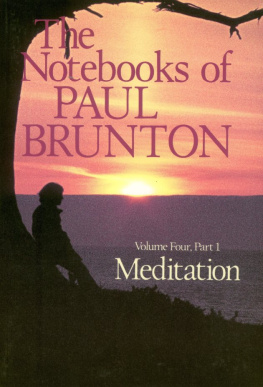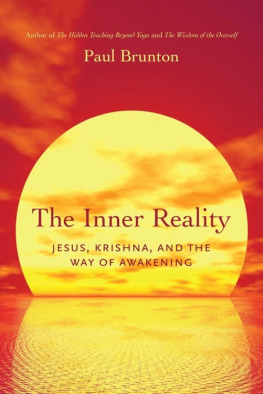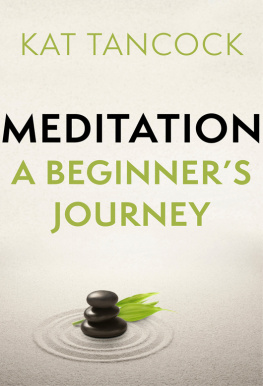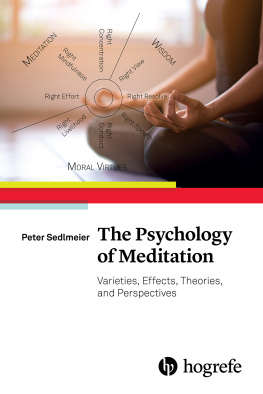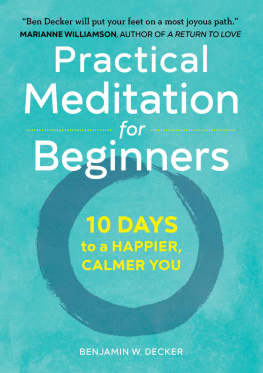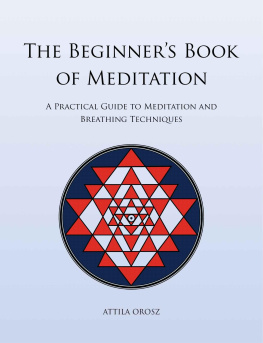Paul Brunton - Meditation
Here you can read online Paul Brunton - Meditation full text of the book (entire story) in english for free. Download pdf and epub, get meaning, cover and reviews about this ebook. year: 1986, publisher: Larson Publications, genre: Religion. Description of the work, (preface) as well as reviews are available. Best literature library LitArk.com created for fans of good reading and offers a wide selection of genres:
Romance novel
Science fiction
Adventure
Detective
Science
History
Home and family
Prose
Art
Politics
Computer
Non-fiction
Religion
Business
Children
Humor
Choose a favorite category and find really read worthwhile books. Enjoy immersion in the world of imagination, feel the emotions of the characters or learn something new for yourself, make an fascinating discovery.
- Book:Meditation
- Author:
- Publisher:Larson Publications
- Genre:
- Year:1986
- Rating:4 / 5
- Favourites:Add to favourites
- Your mark:
- 80
- 1
- 2
- 3
- 4
- 5
Meditation: summary, description and annotation
We offer to read an annotation, description, summary or preface (depends on what the author of the book "Meditation" wrote himself). If you haven't found the necessary information about the book — write in the comments, we will try to find it.
Meditation — read online for free the complete book (whole text) full work
Below is the text of the book, divided by pages. System saving the place of the last page read, allows you to conveniently read the book "Meditation" online for free, without having to search again every time where you left off. Put a bookmark, and you can go to the page where you finished reading at any time.
Font size:
Interval:
Bookmark:




Copyright 1986 Paul Brunton Philosophic Foundation
All rights reserved. Neither the whole nor any part of this book may be reproduced in any form without written permission from the publisher.
International Standard Book Number (cloth) 0-943914-18-3
International Standard Book Number (Part 1, paper) 0-943914-19-1
International Standard Book Number (Part 2, paper) 0-943914-20-5
International Standard Book Number (series, cloth) 0-943914-17-5
International Standard Book Number (series, paper) 0-943914-23-X
Library of Congress Catalog Card Number (cloth) 86-81949
Library of Congress Catalog Card Number (paper) 86-81950
Manufactured in the United States of America
Published for the
Paul Brunton Philosophic Foundation
by
Larson Publications
4936 NYS Route 414
Burdett, New York 14818
Distributed to the trade by
National Book Network
03 05 07 09 11 12 10 08 06 04 02
4 6 7 8 10 11 9 5 3
The works of Paul Brunton
A Search in Secret India
The Secret Path
A Search in Secret Egypt
A Message from Arunachala
A Hermit in the Himalayas
The Quest of the Overself
The Inner Reality
(Discover Yourself)
Indian Philosophy and
Modern Culture
The Hidden Teaching
beyond Yoga
The Wisdom of the Overself
The Spiritual Crisis of Man
Published posthumously
The Notebooks of Paul Brunton
| volume 1: | Perspectives |
| volume 2: | The Quest |
| volume 3: | Practices for the Quest Relax and Retreat |
| volume 4: | Meditation The Body |
| volume 5: | Emotions and Ethics The Intellect |
| volume 6: | The Ego From Birth to Rebirth |
| volume 7: | Healing of the Self The Negatives |
| volume 8: | Reflections on My Life and Writings |
| volume 9: | Human Experience The Arts in Culture |
| volume 10: | The Orient |
| volume 11: | The Sensitives |
| volume 12: | The Religious Urge The Reverential Life |
| volume 13: | Relativity, Philosophy, and Mind |
| volume 14: | Inspiration and the Overself |
| volume 15: | Advanced Contemplation The Peace Within You |
| volume 16: | Enlightened Mind, Divine Mind |
Essays on the Quest
Meditations for People in Charge
Meditations for People in Crisis
What Is Karma?
The Gift of Grace
Commentaries on the Notebooks,
by Anthony Damiani
Looking Into Mind
( On meditation and mentalism )
Standing in Your Own Way
( On the ego )
Living Wisdom
( On the path of knowledge )
EDITORS INTRODUCTION
Meditation is an inspiring invitation to the most intimate adventure of human spiritualitythe direct experience of ones own soul. Here P.B. focuses lucidly on a topic for which his extraordinary expertise has been widely acknowledged since he was a young man in the 1930s. He explains the purpose and importance of meditation, provides an unusually rich variety of tested and proven techniques, explains the potential dangers of meditation, and advises how those dangers can be avoided. This section will prove highly useful to beginners and intermediates alike. It should be welcomed by advanced meditators and teachers of meditation as well.
The fourth category (major theme) in P.B.s overall outline of twenty-eight, this section stands in direct relationship to the twenty-third category, Advanced Contemplation . Because of the editorial decisions involved in distinguishing and presenting these two categories, more is required here by way of introductory explanation than has been necessary for any of the previous sections in this series.
As is the case with previous categories, the selection and sequencing of material here is the work of students and not of P.B. himself. Because of the general unfamiliarity in many parts of the West with meditation, however, and because some fundamental ideas might appear unnecessarily confusing if paras were printed somewhat randomly, we have taken much more care in the sequencing within some of the chapters than is our custom. In this particular case, the risk of imposing unintended meanings by context is far outweighed by the risk of obscuring the fundamental clarity with which P.B. approaches and explains this important practice.
Progress in meditation, the inward penetration to deeper and more satisfying levels of the inner reality, can be schematized in several different ways. Two schemas are important to understanding the vast majority of P.B.s writings on meditation.
The first distinguishes elementary and advanced practices. All the practices involving willed effort, the struggle to overcome the minds inherent restlessness and focus it one-pointedly on a single image/idea/ideal to the exclusion of all else, are considered elementary in this schema. Only after such one-pointed concentration can be maintained indefinitely does one intelligently change over to the rapt, highly alert state of inner passivity requisite for the advanced practices.
This division into elementary and advanced practices is the one that distinguishes the fourth and twenty-third categories from one another in P.B.s general outline. But since the practices considered elementary in such a schema are far from elementary in the practice of most meditators and would-be meditators, and since these practices include nearly all of what is generally recommended by way of meditation to spiritual seekers in the modern West, we felt that P.B.s title of Elementary Meditation could be misleading to the majority of Westerners now practicing some form of meditation. Feeling ourselves forced to offer the present form of introductory explanation in either case, we have chosen to use Meditation as the title on the cover of this volume rather than the somewhat technical term Elementary Meditation from the original outline.
The second general schematization of stages of practice that it will be helpful for readers to understand is threefold. Within the generic term meditation, it distinguishes three stages: concentration, meditation proper, and contemplation. Though there are occasional exceptions and further elaborations, this threefold framework is the one that readers will find most useful in understanding the material in this volume. These three stages are quite clearly explained in the section on Levels of absorption in Chapter 1. The reader should also be aware that the word meditation is sometimes used as a generic term covering all three of these stages, and that it is sometimes used more technically to mean only the second of these three stages. Informed of both these usages, readers should have little difficulty discovering for themselves which meaning is appropriate to individual paras.
Editorial conventions for this category are the same as stated in introductions to earlier volumes. Likewise, (P) at the end of a para indicates that it is one of the relatively few paras we felt it also appears in Perspectives , the introductory volume to this series.
Next pageFont size:
Interval:
Bookmark:
Similar books «Meditation»
Look at similar books to Meditation. We have selected literature similar in name and meaning in the hope of providing readers with more options to find new, interesting, not yet read works.
Discussion, reviews of the book Meditation and just readers' own opinions. Leave your comments, write what you think about the work, its meaning or the main characters. Specify what exactly you liked and what you didn't like, and why you think so.

